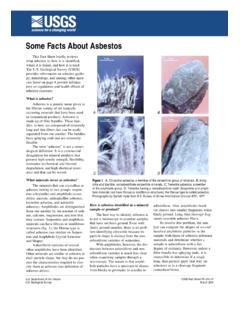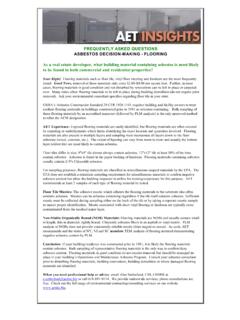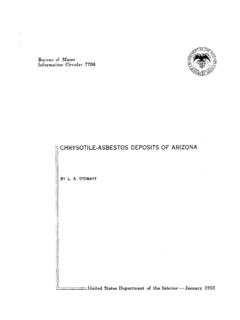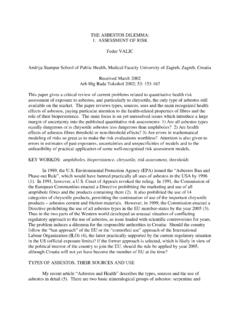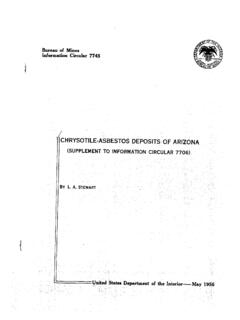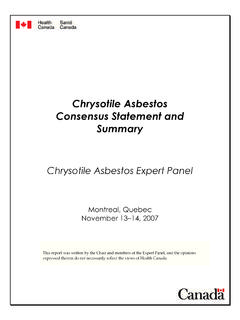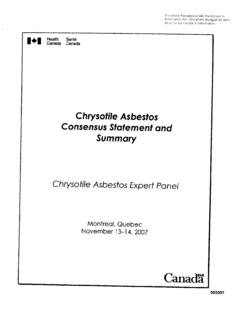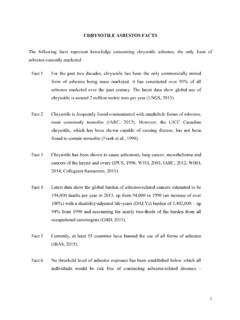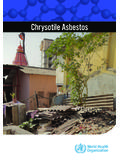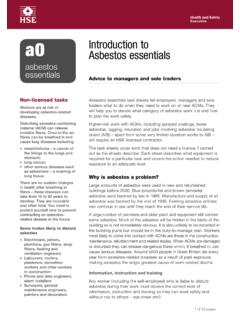Transcription of The risk of mesothelioma from exposure to chrysotile ...
1 Copyright Lippincott Williams & Wilkins. Unauthorized reproduction of this article is risk of mesothelioma from exposure to chrysotile asbestosCharles M. YarboroughPurpose of reviewThis review assesses the risk of developing diffusemalignant mesothelioma of the pleura from exposures tochrysotile fibers and contrasts it with the known risk ofamphibole findingsAlthough a rare cancer, the mortality rates of pleuralmesothelioma continue to be significantly elevated becauseof past occupational exposures to airborne asbestos analyses of occupational epidemiologic studies forhighly exposed workers show a substantially lower potencyand suggest an empiric threshold for chrysotile comparedwith amphibole asbestos .
2 Important kinetic andpathological differences between chrysotile andamphiboles have been substantiated that supportchrysotile s impotency in causing pleural risk of pleural mesothelioma from past exposures toasbestos, as evidenced by a trend of high incidence ratesduring the last half century, appears to be the result ofnonchrysotile asbestiform fibers. Although scientific effortsand legal arguments continue, the risk of pleuralmesothelioma in human populations is probably negligiblefor exposures to airborne chrysotile asbestos that is notknown to be contaminated by amphibole. This distinction forasbestos fiber types is pivotal for understanding hazardsand characterizing risks of continued use of naturalchrysotile asbestos today and also new , chrysotile , mesothelioma , risk assessmentCurr Opin Pulm Med 13:334 338.
3 2007 Lippincott Williams & of Medicine, University Medical Center at Princeton, Princeton, NewJersey, USAC orrespondence to charles M. yarborough , MD, 253 Witherspoon St., Princeton,NJ 08540, USATel/fax: +1 609 737 2929; e-mail: Opinion in Pulmonary Medicine2007, 13:334 338 2007 Lippincott Williams & Wilkins1070-5287 IntroductionThere appears to be an emerging assessment that chryso-tile asbestos has relatively low mesotheliogenic risk assessments and reviews have beenpublished since 2000 [1 4], confirming that chrysotilefibers are substantially less potent than amphibole fibersin inducing mesothelioma . It has been argued for chryso-tile miners in Canada that chrysotile exposure did notcontribute to mesotheliomas [5].
4 A recent, comprehensivereview of worker cohorts supports the conclusion thatchrysotile fibers do not produce mesothelioma [6 ].Recent experimental data also support a low if existentmesotheliogenic potency of chemistryAsbestos is a commercial term used to describe mineralsthat share certain physical properties and is categorizedinto two families: serpentine ( chrysotile , white asbestos )and amphiboles ( crocidolite, amosite, tremolite,anthophyllite and actinolite). Libby amphibole, erionite,balangeroite and other natural fibers appear to possessamphibole-like properties, but they are found in limitedgeographical asbestos type has a distinct chemical formula.
5 Asbes-tos occurs both as asbestiform (fibrous) and nonasbestiform(massive) structures in nature, but each type retains itschemical composition in either form . chrysotile is a sheetsilicate that rolls into nano-sized tubular structurespossessing a hollow core (also seen in carbon nanotubes),whereas amphiboles are chain silicates. chrysotile breaksdown into fibrils that have a surface layer of magnesium(brucite). The acid in lung macrophages (or stomach)weakens and destroys the fibrils [7 ].Fiber dose, fiber dimensions, and fiber durability areproposed to be the three primary factors affecting fibertoxicity [8]. Of the multiple clearance mechanisms fromthe lung to the pleura and other tissues, dissolution rate isa very important factor for comparing biopersistence offibers, which is a major contributor to mesotheliogenicpotency.
6 Consistent with the lack of durability, chrysotileis considerably less biopersistent in the lungs comparedwith the amphibole fibers. The longer fibers break apartinto small particles and smaller fibers that essentiallybecome harmless amorphous silica [7 ]. For fibers longerthan 20mm in animal studies, chrysotile asbestos fromCalidria and Canadian mines cleared the lungs with a halflife of 7 h and days, respectively. By 2 days all longCalidria fibers had dissolved or disintegrated into shorter334 Copyright Lippincott Williams & Wilkins. Unauthorized reproduction of this article is , and no long Canadianfibers were present after1 year in the lung. For in-vitro studies under conditionsanalogous to biological systems, the measured dissolutionrate for crocidolite is 40 times slower than for chrysotile [4,9 11].
7 chrysotile asbestos exposuresExposure assessment is required within the riskassessment paradigm along with hazard identification,dose response assessment and risk high exposures to airborne asbestos ofyesteryear are unlikely today since strict limits wereestablished almost four decades ago. In work settingsstudied by epidemiologists, exposures to asbestosfiberswere very high during the decades of the twentiethcentury, preceding progressively more strict exposurecontrols [6 ].Methods for measuring asbestosfiber exposures havechanged greatly over the decades, and speciation offibertypes in air samples has been done infrequently afteraccurate measurement techniques were estimates of chrysotilefibers of the past arequestionably valid becausefibers were neither directlymeasured nor analyzed; they were not required byregulatory agencies.
8 Phase contrast microscopy (PCM)is necessary for regulatory compliance of OccupationalSafety and Health Administration (OSHA) and otheragencies, but PCM does not distinguishfiber types,lacks analytical capability and has limited electron microscopy (TEM) addressesthese limitations and is used in studies now in tandemwith PCM, but there are still no health-based exposureguidelines for interpreting the results [12]. In addition,TEM was not available during the pertinent period ofexposures in most asbestos epidemiologic studies usedfor risk assessment 1968 a specific hygiene limit for chrysotile in work-place air was proposed [13].
9 Only recently has a jobexposure matrix been identified to provide informationon exposure intensity and asbestosfiber type andlength, designed for interpreting epidemiology results[14]. exposure monitoring forfiber types obtainedprospectively is being carried out. For example, asbestos -monitored truck drivers during World TradeCenter (WTC) cleanup operations have exposuresmostly to low levels of chrysotile withfiber lengthspredominately less than 5mm [12].Merely using a chrysotile product does not indicate thatexposures are significant ( iffibers are encapsulated ina material). Working with naval gaskets and packingresulted in air concentrations indistinguishable fromambient ship levels or in the general environment [15].
10 Fiber exposures in the past while servicing car brakeswith pads, a chrysotile -containing product with resinmaterial, were found to be very low [16]. asbestos concentrations in the ambient environmenthave been reconstructed for the entire twentieth centuryby using a combination of methods. It appears thatchrysotile asbestos concentrations peaked mid centuryat approximately , the current OSHA asbestos limit for 8 h, and then decreased in the lastquarter of the century [17,18 ].EpidemiologyIn the US, age-adjusted mortality rates for 1999 2001show that males have a six-fold higher rate ( )than females ( ), and the distribution of cases ispredominatelycoastal[19 ].
